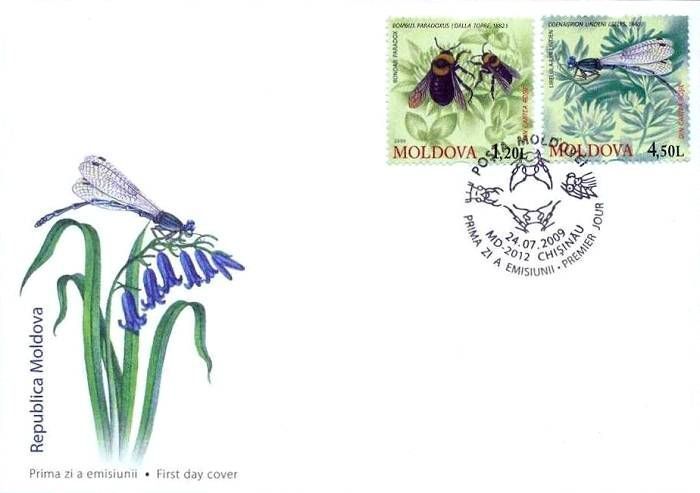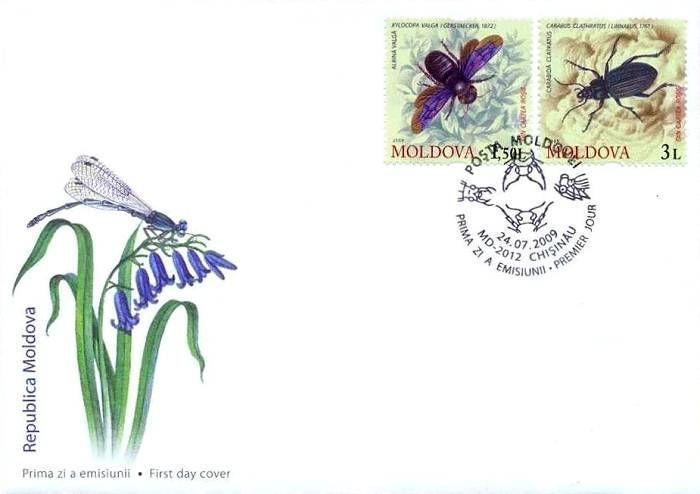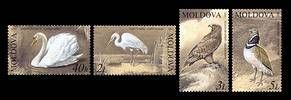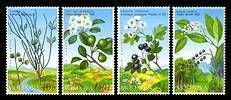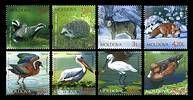POSTAGE STAMPS
|
|
Bumblebee
- Michel Catalogue No: 659
- Perforation Type/Size: Comb Syncopated 13
- Size: 34.00 x 34.00 mm
- Face Value: 1.2 Lei
- Quantity Printed: 150,000
|
A bumblebee is any member of the bee genus Bombus, in the family Apidae. There are over 250 known species, existing primarily in the Northern Hemisphere although they also occur in South America. They have been introduced to New Zealand and the Australian state of Tasmania. Read more..
This article uses material from the Wikipedia article 'Bumblebee', which is released under the Creative Commons Attribution-Share-Alike License 3.0. |
| |
|
Carpenter Bee
- Michel Catalogue No: 660
- Perforation Type/Size: Comb Syncopated 13
- Size: 34.00 x 34.00 mm
- Face Value: 1.5 Lei
- Quantity Printed: 150,000
|
Carpenter bees (the genus Xylocopa in the subfamily Xylocopinae) are large bees distributed worldwide. There are some 500 species of carpenter bee in 31 subgenera. Their name comes from the fact that nearly all species build their nests in burrows in dead wood, bamboo, or structural timbers (except those in the subgenus Proxylocopa, which nest in the ground). Members of the related tribe Ceratinini are sometimes referred to as 'small carpenter bees'. Read more..
This article uses material from the Wikipedia article 'Carpenter_bee', which is released under the Creative Commons Attribution-Share-Alike License 3.0. |
| |
|
Carabus Beetle
- Michel Catalogue No: 661
- Perforation Type/Size: Comb Syncopated 13
- Size: 34.00 x 34.00 mm
- Face Value: 3 Lei
- Quantity Printed: 100,000
|
Carabus is a genus of beetle in family Carabidae. The genus is highly diverse with 91 subgenera and more than 900 recognised species. The vast majority are native to the Palearctic, but there are also 11 Nearctic species. Carabus are 12–50 mm (0.47–2.0 in) long, most species are wingless and often very colourful. These are nocturnal, predatory beetles that feed on snails, earthworms and caterpillars. Read more..
This article uses material from the Wikipedia article 'Carabus', which is released under the Creative Commons Attribution-Share-Alike License 3.0. |
| |
|
Goblet-Marked Damselfly
- Michel Catalogue No: 662
- Perforation Type/Size: Comb Syncopated 13
- Size: 34.00 x 34.00 mm
- Face Value: 4.5 Lei
- Quantity Printed: 100,000
|
The Goblet-marked damselfly (Erythromma lindenii) is a medium-sized blue-and-black (or green-and-black) damselfly in the pond damselfly family (Coenagrionidae). It's a fairly common species in the South and West of Europe but is not found in the British Isles, Scandinavia and Eastern Europe. Erythromma lindenii was previously known as Coenagrion lindenii and Cercion lindenii. The Goblet-marked Damselfly is also known as the Blue-eye. It's an easily recognized species, with its wide antehumeral stripes, narrow postocular spots, the male's very bright-blue eyes. He has very long and curved appendages, and the spear-shaped marks on S3-S6 of his abdomen. It can also be found in Asia: Russian Federation and it is also found in Africa. Read more..
This article uses material from the Wikipedia article 'Goblet-marked_Damselfly', which is released under the Creative Commons Attribution-Share-Alike License 3.0. |
| |




